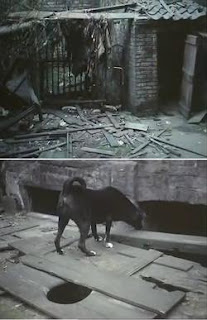The Illustrated Police News was a weekly illustrated newspaper which was one of the earliest British tabloids. It featured sensational and melodramatic reports and illustrations of murders and hangings and was a direct descendant of the execution broadsheets of the 18th century. Founded in 1864 ceased publication in 1938.
Annie Chapman was born Eliza Ann Smith, c. 1840 and died a horrific death on 8 September 1888. Annie was a victim of the notorious still unidentified to this day serial killer Jack the Ripper. The Ripper killed and mutilated several women in the Whitechapel area of London from late August to early November 1888.
Annie Chapmans body was discovered by resident John Davis in the yard of 29 Hanbury street Whitechapel.
In 1888, 29 Hanbury street consisted of eight rooms with a total of seventeen people living inside. The ground floor was occupied by Mrs. Harriet Hardiman and her 16 year old son. Both of them slept in the front room which doubled as a shop where they sold cat's meat. The rear room was used as a kitchen.
The first floor front room belonged to Mrs. Amelia Richardson and her 14 year old grandson. She had lived here for 15 years. Her business was making packing cases, employing her son, John, who did not live on the premises. She also rented the cellar, which was used in manufacturing, and the yard. The first floor back room was shared by a Mr. Waker, a maker of tennis boots, and his adult son who had a mental disability but at the time was referred to as a retard.
The second floor front room contained a family consisting of a carman named Thompson who worked at Goodson's in Brick Lane, his wife and adopted daughter. The back room was shared by two unmarried sisters named Copsey who worked in a cigar factory.
The third floor attic front room was occupied by an elderly man, John Davis who was also a carman and a market porter and his wife and three sons. the attic rear belonged to Sarah Cox, an elderly woman whom Mrs. Richardson kept out of charity.
Dr George Bagster Phillips, the police surgeon, described Annie Chapman’s body as he saw it at 6:30 a.m. in the back yard of the house at 29 Hanbury Street:
The left arm was placed across the left breast. The legs were drawn up, the feet resting on the ground, and the knees turned outwards. The face was swollen and turned on the right side. The tongue protruded between the front teeth, but not beyond the lips. The tongue was evidently much swollen. The front teeth were perfect as far as the first molar, top and bottom and very fine teeth they were. The body was terribly mutilated ... the stiffness of the limbs was not marked, but was evidently commencing. He noticed that the throat was dissevered deeply; that the incision through the skin were jagged and reached right round the neck ... On the wooden paling between the yard in question and the next, smears of blood, corresponding to where the head of the deceased lay, were to be seen. These were about 14 inches from the ground, and immediately above the part where the blood from the neck lay. ...
The instrument used at the throat and abdomen was the same. It must have been a very sharp knife with a thin narrow blade, and must have been at least 6 to 8 inches in length, probably longer. He should say that the injuries could not have been inflicted by a bayonet or a sword bayonet. They could have been done by such an instrument as a medical man used for post-mortem purposes, but the ordinary surgical cases might not contain such an instrument. Those used by the slaughtermen, well ground down, might have caused them. He thought the knives used by those in the leather trade would not be long enough in the blade. There were indications of anatomical knowledge ... he should say that the deceased had been dead at least two hours, and probably more, when he first saw her; but it was right to mention that it was a fairly cool morning, and that the body would be more apt to cool rapidly from its having lost a great quantity of blood. There was no evidence ... of a struggle having taken place. He was positive the deceased entered the yard alive ...
A handkerchief was round the throat of the deceased when he saw it early in the morning. He should say it was not tied on after the throat was cut.
Annie Chapman was buried on 14 September 1888. At 7:00 am that day, a hearse supplied by Hanbury Street undertaker H. Smith went to the Whitechapel Mortuary in Montague Street, the utmost secrecy having been observed, and none but the undertaker, police, and relatives of the deceased knowing anything about the arrangements. Her body was placed in a black-draped elm coffin and was then driven to Harry Hawes, a Spitalfields undertaker, who arranged the funeral. At 9:00 am, the hearse (without mourning coaches so as not to attract the public's attention) took the body to the Manor Park Cemetery, Sebert Road, Forest Gate, London, where she was buried in a public grave.
Her relatives, who paid for the funeral, met the hearse at the cemetery and, by request, kept the funeral a secret and were the only mourners to attend. The coffin bore the words "Annie Chapman, died Sept. 8, 1888, aged 48 years." Chapman's grave no longer exists; it has since been buried over. In 2008, the cemetery authorities decided to mark her grave with a plaque.

















































